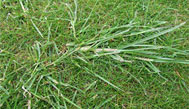Rescue Your Rough This Autumn
04 Sep 2012

Thick rough has been the bane of every golfers' game this season. The incredibly wet conditions have encouraged excessive coarse grass growth and prevented mowing, which has resulted in almost unplayable conditions on many golf courses.
The Syngenta Golf Player Survey revealed that thick, coarse
rough is the number one complaint among golfers. Over 50% of
golfers were dissatisfied with the state of thick rough, with over
70% stating ease of ball location as a high priority. The drastic
action, where coarse rough is causing slow rounds, lost balls and
immense frustration has been to cut it all to the ground, leaving a
prairie course of limited
interest or challenge to golfers.
The good news is that the wet, warm soils and vigorous growth
are ideal conditions for Rescue herbicide treatment, to selectively
remove ryegrass and create an open sward of fine Fescue grass
species, according to Syngenta Technical Manager, Dr Simon Watson.
The conditions will also help with over sowing or reseeding rough
areas with fine Fescue grass species, he added.
"Selectively removing the thick, coarse Ryegrasses now can
significantly enhance playing conditions for next season. Autumn
treatments, as the grass is dying back naturally, have the minimum
visual impact on the course. Where over sowing is used, the new
Fescue grasses will establish for next spring to fill any
gaps."
When over seeding dense rough with a high proportion of Ryegrass,
it is preferable to wait until the coarse grasses have started to
die back from the Rescue treatment, he advised. The aim is to
reduce competition and open the sward that will allow new seedlings
to establish.
Dr Watson advocates that over sowing with Fescue species will
create a faster transition to fine, wispy rough. "Fescue dominated
rough can be more effectively managed, with lighter annual cutting
and less trimmings to remove - further reducing the fertility and
creating a more sustainable, low-cost sward.
"If Ryegrass does begin to re-infest the sward, it can be quickly
and easily removed with Rescue in spring or autumn," he
added.
Dr Watson advises that Rescue can be applied at the rate of 1.33
l/ha from May through to the end of September, but must then be
reduced to 1.0 l/ha for later autumn or early spring
applications.
Rough spraying application advice
Sprayer operators treating deep rough must remember to raise
the boom height of the sprayer to maintain even coverage on taller
leaves. The optimum is to spray at 50cm nozzle height above the
spray target zone, advised Dr Watson.
With a foliar application, using a systemic herbicide active that
will be drawn down into the plant, it is essential to retain as
much spray on the leaf surface as possible. Spraying in the minimum
water volume of 250 l/ha will reduce the risk of over wetting
leaves and optimise retention, whilst increasing sprayer output per
fill.
Furthermore, using the angled Syngenta Turf Nozzle with its
rearwards facing spray pattern will counteract the forwards
movement of the sprayer and deliver better all-round coverage of
tall vertical leaves, compared to standard vertical flat fan
nozzle.
Engaging player support
The extremely difficult playing conditions caused by dense rough
will make players and club management more receptive to initiatives
to tackle the issues, and to support investment in
improvements.
The Syngenta Golf Player Survey revealed that thick, coarse rough
is the number one complaint among golfers. Over 50% of golfers were
dissatisfied with the state of thick rough, with over 70% stating
ease of ball location as a high priority.
Loch Lomond Golf Club Course Estate Manager, David Cole, reported
some of the rough areas had got out of control. But initiatives to
thin out these rough areas and bring back the original Fescue
dominant swards are now paying dividends. The targeted use of
Rescue in areas where coarse grasses have dominated, along with
Primo Maxx used to suppress growth from competing grasses, have
favoured the Fescues.
Mr Cole added that repeated over seeding and the installation of
drainage in the rough areas, along with applications of appropriate
fertiliser and iron, have also helped. "We are getting back to
rough areas that can be used to define the design of the course,
without impinging on the players' game too severely. It all looks
better and is playing better."
Faster results
At the London Club in Kent, Course Manager, Peter Todd,
commented that the club is keen to adopt new technology and
agronomy techniques that can enhance the efficiency of turf
management and the quality of playing conditions. He highlighted
that Rescue treatments have proved extremely successful in managing
coarse grass invasion in the rough - a legacy of the site's
agricultural origins.
After years of conventional agronomy measures to cut, scarify and
remove the coarse grasses, introducing Rescue as part of the
control programme has enabled a faster reversion to the desirable
fine grass species.
"It's all about playability," said Mr Todd. "The aim was to
eradicate the coarse grasses and produce less dense, tall rough,
which would still penalise wayward shots, but at least enabled
players to find their ball and keep moving.
"Dense, thick rough is frustrating for golfers and slows up play,
which ultimately has an adverse effect on the bottom line. Green
clumps of coarse grass also spoil the visually attractive golden
brown colour and wispy seed heads. Creating the desirable thin
rough is far better for the players, and for the effective
long-term management of the course."
